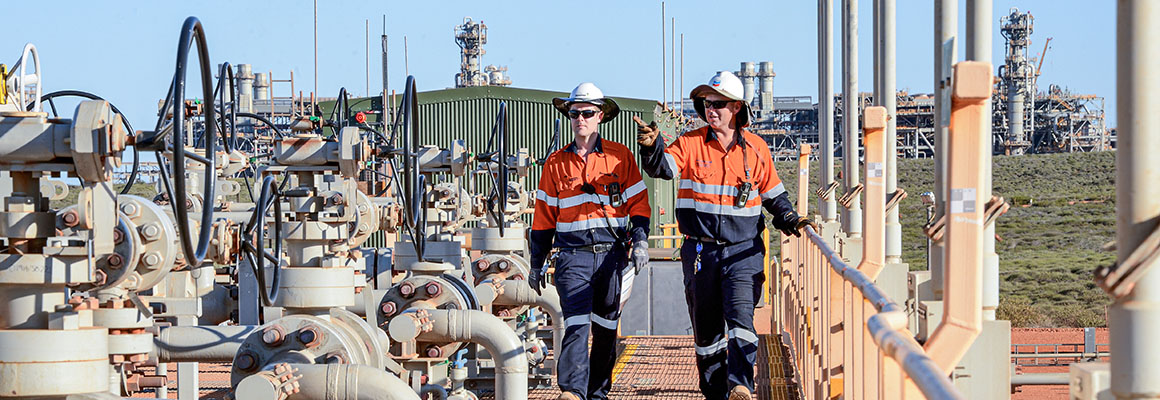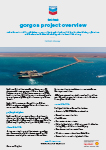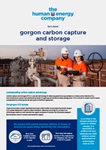media statement
Safe start up and operation of the carbon dioxide injection system at the Gorgon natural gas facility

PERTH, Western Australia, 8 August 2019 – Chevron Australia and the Gorgon Joint Venture participants today announced the safe startup and operation of the carbon dioxide injection system at the Chevron-led Gorgon natural gas facility on Barrow Island, off the northwest coast of Western Australia.
Chevron Australia managing director Al Williams said, “We are pleased to reach the first milestone of safely starting the operation of the Gorgon carbon dioxide injection system, one of the world’s largest greenhouse gas mitigation projects ever undertaken by industry.
“This achievement is the result of strong collaboration across industry and governments and supports our objective of providing affordable, reliable and ever-cleaner energy essential to our modern lives.
Williams added, “We are monitoring system performance and plan to safely ramp up injection volumes over the coming months as we bring online processing facilities.”
Once fully operational, the carbon dioxide injection facility will reduce Gorgon’s greenhouse gas emissions by about 40 percent, or more than 100 million tonnes over the life of the injection project.
The Gorgon facility incorporates many leading design features aimed at maximising energy efficiency and minimising greenhouse gas emissions. In steady-state operations, Gorgon is anticipated to have the lowest greenhouse gas emissions intensity of any LNG project in Australia.
Contact: Kathryn Ackroyd +61 (8) 9485 5344 (Perth)
Notes to the Editor:
- The Chevron-operated Gorgon Project is a joint venture between the Australian subsidiaries of Chevron (47.3 percent), ExxonMobil (25 percent), Shell (25 percent), Osaka Gas (1.25 percent), Tokyo Gas (1 percent) and JERA (0.417 percent).
- The Australian Government has contributed $60 million towards the capital cost of the Carbon Dioxide Injection Project as part of the Low Emissions Technology Demonstration Fund.
Images: Chevron Australia personnel at the Chevron-operated
Gorgon carbon dioxide injection facility on Barrow Island.
gorgon carbon dioxide injection project
NOTICE
CAUTIONARY STATEMENT RELEVANT TO FORWARD-LOOKING INFORMATION
FOR THE PURPOSE OF “SAFE HARBOR” PROVISIONS OF THE
PRIVATE SECURITIES LITIGATION REFORM ACT OF 1995
This press release contains forward-looking statements relating to Chevron’s operations that are based on management’s current expectations, estimates and projections about the petroleum, chemicals and other energy-related industries. Words or phrases such as “anticipates,” “expects,” “intends,” “plans,” “targets,” “forecasts,” “projects,” “believes,” “seeks,” “schedules,” “estimates,” “positions,” “pursues,” “may,” “could,” “should,” “budgets,” “outlook,” “trends,” “guidance,” “focus,” “on schedule,” “on track,” “is slated,” “goals,” “objectives,” “strategies,” “opportunities” and similar expressions are intended to identify such forward-looking statements. These statements are not guarantees of future performance and are subject to certain risks, uncertainties and other factors, many of which are beyond the company’s control and are difficult to predict. Therefore, actual outcomes and results may differ materially from what is expressed or forecasted in such forward-looking statements. The reader should not place undue reliance on these forward-looking statements, which speak only as of the date of this report. Unless legally required, Chevron undertakes no obligation to update publicly any forward-looking statements, whether as a result of new information, future events or otherwise.
Among the important factors that could cause actual results to differ materially from those in the forward-looking statements are: changing crude oil and natural gas prices; changing refining, marketing and chemicals margins; the company’s ability to realize anticipated cost savings and expenditure reductions; actions of competitors or regulators; timing of exploration expenses; timing of crude oil liftings; the competitiveness of alternate-energy sources or product substitutes; technological developments; the results of operations and financial condition of the company’s suppliers, vendors, partners and equity affiliates, particularly during extended periods of low prices for crude oil and natural gas; the inability or failure of the company’s joint-venture partners to fund their share of operations and development activities; the potential failure to achieve expected net production from existing and future crude oil and natural gas development projects; potential delays in the development, construction or start-up of planned projects; the potential disruption or interruption of the company’s operations due to war, accidents, political events, civil unrest, severe weather, cyber threats and terrorist acts, crude oil production quotas or other actions that might be imposed by the Organization of Petroleum Exporting Countries, or other natural or human causes beyond its control; changing economic, regulatory and political environments in the various countries in which the company operates; general domestic and international economic and political conditions; the potential liability for remedial actions or assessments under existing or future environmental regulations and litigation; significant operational, investment or product changes required by existing or future environmental statutes and regulations, including international agreements and national or regional legislation and regulatory measures to limit or reduce greenhouse gas emissions; the potential liability resulting from other pending or future litigation; the company’s future acquisition or disposition of assets or shares or the delay or failure of such transactions to close based on required closing conditions; the potential for gains and losses from asset dispositions or impairments; government-mandated sales, divestitures, recapitalizations, industry-specific taxes, changes in fiscal terms or restrictions on scope of company operations; foreign currency movements compared with the U.S. dollar; material reductions in corporate liquidity and access to debt markets; the impact of the 2017 U.S. tax legislation on the company’s future results; the effects of changed accounting rules under generally accepted accounting principles promulgated by rulesetting bodies; the company’s ability to identify and mitigate the risks and hazards inherent in operating in the global energy industry; and the factors set forth under the heading “Risk Factors” on pages 19 through 22 of the company’s Annual Report on Form 10-K. Other unpredictable or unknown factors not discussed in this report could also have material adverse effects on forward-looking statements.




